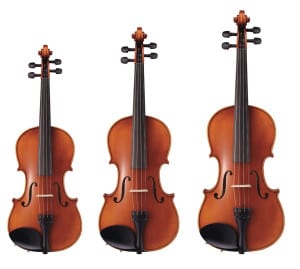Like Shoes, Kids Outgrow Orchestra Instruments
Nov 11, 2015

When is the right time to move your child to a larger orchestra instrument?
It’s inevitable. Children seem to outgrow things just as soon as you buy them. Much like shoes, clothes, sports equipment and more, your child outgrows his or her orchestra instrument too. Since playing an instrument that’s too small doesn’t hurt the feet like wearing tight shoes does, you may not hear any complaints. It’s easy to “make do” for a while or not even realize the time has come to move up to a larger size.
For your child to play at his or her full potential, you need to make sure that they are using an instrument that is the right size. After all, if he or she was playing a sport, you would not want them to use sports equipment that was too big or small that could impair their performance or increase the odds of an injury. Playing an instrument that is too small for him or her can stunt musical growth.
What are the different orchestra instrument sizes?
Making do with instruments of the wrong size is problematic for a couple of reasons. First, as children grow, they will find it harder and harder to use the instruments that were appropriately sized for their younger (and smaller) selves. They will probably be able to make do for a time, but that will become more and more cumbersome as they continue to grow, which can lead to serious consequences for their performance, their love of music, and even their health. Bad posture can result from playing the wrong-sized instrument and is often blamed for a musician suffering repetitive motion injuries.
Second, making the switch to a bigger instrument is important because their smaller counterparts tend not to sound as good. Instruments are meant to be a specific size, which results in a specific sound. As a result, smaller versions of full-sized instruments tend to produce a weaker sound without the instrument's full range and richness. In other words, your child’s instrument increases in size and quality to match their improving skill.
With that said, choosing the right instrument size is much easier said than done. There is no such thing as a single standardized system for all instruments out there. Full size means that the instrument is performance level, but fractional does not necessarily mean what it seems. For example, a 3/4 violin is not 3/4 the size of a full-sized violin. Instead, it is 1 inch shorter when 3/4 the length of a full-sized violin means that it should be 4 inches shorter.
How to choose the right sized orchestra instrument?
With a little expert advice and measuring from Meyer Music’s experts, you will have no problems finding the right sized instrument for your child. We can recommend instrument sizes for musicians based on the length of their arms, as well as other key measurements.
Since children grow so quickly, many parents across the Kansas City area rent their child’s orchestra instruments from Meyer Music to minimize cost. For example, you can rent if you are not sure that your child is going to stick with a particular instrument or is still growing (compared to high school aged-students). Once your student musician has reached his or her adult height (or close to it), our experts can help you select the full-sized instrument best suited to your child, as well as other options available with these performance-level instruments, including material, finish, bows, pegs, chin rests, and tail pieces.
Meyer Music offers free measurements anytime.
Bring your child and his or her orchestra instrument to any Meyer Music location for a free measurement. One of our experts is happy to ensure your child is playing the instrument perfectly sized for him or her.

